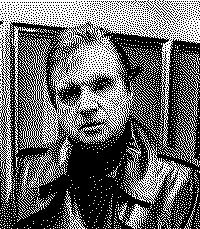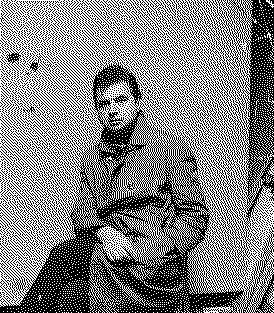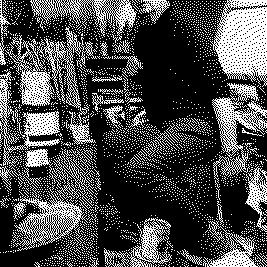Artists/Francis Bacon
Fast Facts
Figurative Expressionism
Bacon is celebrated for his figurative painting style, which is often categorized as Expressionist. His work is known for its emotional intensity and raw energy.
Distorted Forms and Figures
His paintings often feature distorted human figures, sometimes set in abstract, cage-like spaces. These distorted forms are a signature element of his work, conveying a sense of emotional turmoil and existential angst.
Themes of Isolation and Despair
Many of his works explore themes of isolation, despair, and the human condition. He was known for his raw depiction of these themes, often in a disturbing or unsettling manner.
Use of Photography
Bacon often used photography as a source for his paintings, particularly the works of photographer Eadweard Muybridge and the portraits by John Deakin.
Biography



Francis Bacon was a towering figure in 20th-century art, known for his emotionally charged and raw figurative paintings. Born on October 28, 1909, in Dublin, Ireland, Bacon's life was marked by a complex interplay of personal hardships, self-exploration, and artistic innovation.
His innovative and bold works, although inspired by popular culture, music, and sports, were deeply personal rather than overtly political. Hendricks expressed that his paintings were about people who were part of his life, offering a glimpse into the personal connection he felt to his subjects.
Growing up in Philadelphia, Hendricks was raised in a household where his father worked in construction and his mother was a homemaker before becoming a teacher's aide. He was one of five children, and after graduating from Simon Gratz High School, he pursued his passion for art at the Pennsylvania Academy of the Fine Arts. It was during his studies here that Hendricks embarked on a life-changing trip to Europe, where he visited numerous museums and was both enchanted by the beauty of the portraits he saw and dismayed by the lack of Black representation. This experience motivated him to fill that void in the art world.
After completing his certificate at the Academy of the Fine Arts in 1967, Hendricks enlisted in the New Jersey National Guard and began working as an art teacher. His early career also saw him exploring the aesthetics of basketball through painting, an interest that stemmed from his love for the sport. Hendricks furthered his education and skills at Yale University, where he earned both bachelor's and master's degrees in fine arts within two years. He later taught at Connecticut College until his retirement in 2010.
Hendricks's work, particularly during the Black Power movement, was often scrutinized for political messages, even though he maintained that his focus was on portraying the individuals in his life. His famous piece "Lawdy Mama" (1969), for instance, features a subject with an Afro hairstyle reminiscent of Angela Davis, yet Hendricks insisted the painting was of someone from his personal circle.
Notably, Hendricks's paintings such as "Icon for My Man Superman" (1969) and "Brilliantly Endowed" (Self-portrait, 1977) have been especially influential, inspiring tributes from artists like Fahamu Pecou and Rashid Johnson. During the 1980s, specifically the Reagan era, Hendricks took a hiatus from portrait painting to focus on landscapes and photography, only to return with renewed vigor to portraiture in the last fifteen years of his life, showcasing his versatility and depth as an artist.
Hendricks's legacy is vast, including the significant impact of his first career retrospective, "Barkley L. Hendricks: Birth of the Cool," which highlighted his contributions to art from 1964 to 2008. His work continues to inspire, as seen in exhibitions and tributes that celebrate his influence on contemporary portraiture and the representation of Black figures in art.
Hendricks's contributions to art were recognized up until his death on April 18, 2017, in New London, Connecticut, leaving behind a rich legacy that continues to influence and inspire. His life and work exemplify a commitment to depicting the reality and beauty of Black lives, making a lasting impact on the art world (Wikipedia) (Encyclopedia Britannica).
Importance
Francis Bacon's significance in the art world is multifaceted, highlighting his role as a master of figurative painting, an innovator of emotional depth, and a pioneer in expressing the human condition. His impact is outlined through various aspects of his career and influence:
Innovator of Emotional and Psychological Depth
Bacon's art delves deep into the complexities of human emotions and psychological states, using abstracted figurations to portray extreme conditions of the mind and soul. His ability to capture and communicate the rawness of human experiences, often rooted in his own life's tumults, sets him apart as a pivotal figure in post-war art (Wikipedia) (The Art Story) (The Museum of Modern Art).
Master of Figurative Expressionism
Rejecting the abstraction trends of his time, Bacon chose to focus on a distinctive and disturbing realism. His works, notable for their intensity and raw power, pushed the boundaries of figurative painting. Bacon's unique approach to depicting the human form and his exploration of themes like isolation, despair, and vulnerability contributed significantly to the evolution of figurative art in the 20th century (The Art Story) (Encyclopedia Britannica).
Influential across Art and Literature
Bacon's work was not only influenced by other artists such as Velázquez, Giacometti, Van Gogh, and Matisse but also by literary figures like Racine, Baudelaire, and Proust. His interdisciplinary inspirations highlight his importance in bridging the worlds of visual art and literature, showcasing his ability to distill complex human experiences into compelling visual narratives (Artsy).
Cultural Icon and Social Figure
Beyond his contributions to art, Bacon's lifestyle and personality made him a significant cultural icon. Known for his decadent lifestyle and the vibrant social circles he moved in, Bacon's persona contributed to his legend, blending his artistic genius with a flair for the dramatic and the extravagant. His approach to life and art left a lasting impact on both the art world and the broader cultural landscape (Artsy).
Record-Setting Market Value
Since his death, Bacon's work has grown in acclaim, becoming some of the most expensive and sought-after on the art market. Major works, including his early 1950s pope paintings and 1960s portraits, have re-emerged to set record prices at auction, underscoring his enduring relevance and appeal in the contemporary art world (Wikipedia).
Technique
Francis Bacon's painting technique is renowned for its capacity to convey the deep psychological and emotional states of his subjects, blending innovation with traditional influences.
Influence of Earlier Masterpieces and Styles
Bacon's work shows a profound engagement with the art of the past, including influences from Surrealism, film, photography, and Old Masters like Velázquez. His famous series of "screaming popes" was notably inspired by Velázquez's portrait of Pope Innocent X, showcasing Bacon's ability to reinterpret and transform established artistic motifs through his unique lens (The Art Story) (The Museum of Modern Art).
Use of Anatomical and Motion Studies
Bacon's painting "Two Figures" is an example of how he used studies of anatomy and Eadweard Muybridge's motion photography to explore the human body in action. This approach allowed him to represent the dynamic forms and emotional intensity of the human figure, blurring the lines between movement and stillness, presence and absence (The Art Story).
X-radiography in Artistic Process
Bacon's creative process sometimes included significant alterations to his compositions, as revealed by X-radiography. This technique has unveiled compositional changes and underlying imagery in his works, suggesting a more deliberate and complex layering of elements than might initially appear. For instance, X-rays of his paintings have disclosed hidden layers and adjustments, indicating that Bacon's creative process was highly experimental and involved constant revision and exploration (The Museum of Modern Art).
Biomorphism and the Human Figure
Bacon's engagement with biomorphism, influenced by Picasso's work, introduced him to abstract forms that resemble natural, organic shapes. This element is present throughout his oeuvre, particularly in his interpretations of the human body and in motifs like the crucifixion, which he used to express the emotional turmoil of humanity post-World War II (My Modern Met).
Legacy and Preservation of His Studio
After Bacon's death, his London studio was meticulously relocated to Dublin, allowing visitors to view his work environment preserved exactly as he left it. This unique preservation effort offers insight into Bacon's chaotic yet creative working conditions, which were filled with the photos, books, and materials that inspired his paintings (My Modern Met).
Themes
Existential Anguish and Alienation
Mortality and the Human Condition
Violence and Suffering
The Body in Motion
Eroticism and Sexuality
Relationships and Love
Self-Examination
Influence of Past Masters
Mythology and Historical Imagery
Isolation and Confinement
Chronology
- 1930s
1930s
- 1940s
1940s
- 1950s
1950s
- 1960s
1960s
In the 1960s, Francis Bacon's work underwent significant developments, marking a period of intense creativity and the solidification of his reputation within the art world. A pivotal moment came in 1962 when Bacon was honored with a retrospective at Tate Britain in London. This exhibition was crucial for Bacon, not just in terms of recognition but also for the opportunity it presented to revisit and explore themes central to his work. One of the standout pieces that Bacon completed just in time for this retrospective was "Three Studies for a Crucifixion" (1962), a work that returned to the subject of the crucifixion, which Bacon considered a "magnificent armature" for expressing a range of feelings and sensations (Francis Bacon). The 1960s saw Bacon delve deeply into the theme of portraiture, primarily focusing on people he knew well, such as close friends and lovers. This decade is notably marked by the entrance of George Dyer into Bacon's life and art. Dyer, a petty criminal from the East End of London, became Bacon's partner and the subject of many of his paintings, immortalizing Dyer in works such as "Three Studies for a Portrait of George Dyer" (1963). Bacon's approach to portraiture was unique; he often worked from photographs rather than live models, citing a preference for the detachment and abstraction this method provided. Many of the photographs he used were taken by John Deakin, a friend and former Vogue photographer, whose candid shots Bacon found particularly compelling for their rawness and intensity (Francis Bacon). Throughout the 1960s, Bacon's work continued to be characterized by a deep exploration of the human condition, with a focus on the themes of isolation, despair, and the visceral reality of human existence. Despite the personal tragedy of Dyer's suicide in 1971, which profoundly affected Bacon, his work from the 1960s remains a testament to his ability to convey complex emotional states through his unique visual language (Wikipedia). This period in Bacon's career is significant for its contribution to the narrative of post-war art, offering a stark, uncompromising vision of humanity that continues to resonate with audiences today. Bacon's paintings from the 1960s, with their emphasis on the raw and the real, cemented his place as one of the most important and influential artists of the 20th century.
- 1970s
1970s
- 1980s
1980s
- 1990s
1990s









